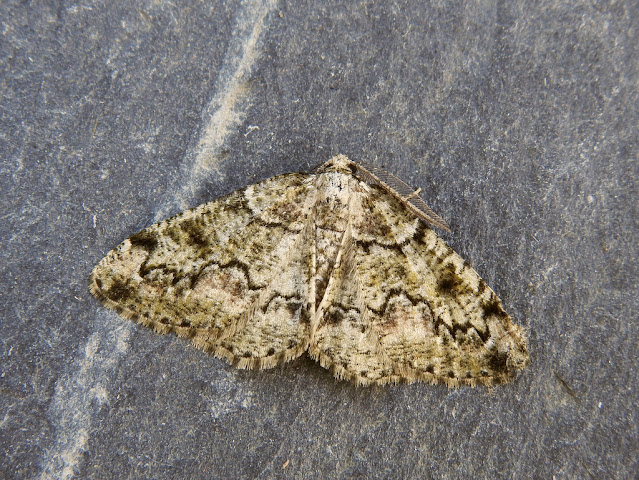There are many ways that time spent birding can be elevated from 'a nice walk
with bins' to another level entirely. Brilliant views of a favourite species
can do it; some engaging and unusual behaviour perhaps, or a lively bit of
passage. And for me, chancing upon a scarce or rare bird is always a winner.
Mmmm...the rarity buzz. Heady stuff.
I've discovered that mothing is similar. And when it comes to the rarity buzz,
the sheer number of moth species inevitably increases the potential
opportunities to experience it. What is more, you are not limited only to
migrant species. For example, let me introduce you to the rarest moth I've
caught in a while...

|
This unspectacular little micro is less than 6mm long. Caught on
Saturday evening.
|
The Dorset Moth Group uses a facility called Living Record to collate the
county's moth records. By accessing the distribution map for any given species
you instantly get an idea of its status within the county. Here is the Living
Record map for Lampronia morosa in Dorset...

|
That colourful dot near West Lulworth represents a single record!
|
As far as I am aware, Living Record only goes back around 20 years or so (and
I doubt it's an exhaustive representation even then) but it certainly provides
an excellent overview. So, Lampronia morosa is definitely a rare
moth in Dorset. Even better, a quick trawl through several other county moth
group websites suggests that it is pretty rare everywhere. In fact the species
is officially designated 'Nationally Scarce'. On top of this, the larvae feed
on roses (wild and cultivated) and I caught it with a net (that's another
story for another post!) next to the garden's new wildlife hedge, which
contains Dog Rose. So it is quite feasible that this rare moth is
breeding in our garden!
Later that same evening I spotted a small geometrid moth dive into the trap shortly
after dark, and in the morning extracted this...

|
Grass Rivulet
|
I didn't recognise it, but soon worked out the ID. Imagine my surprise when I
checked the Living Record map and saw a big blank space around Bridport...

|
No Bridport area records at all, and those blue dots at nearby Charmouth and
Beaminster represent a single record each; the Portland dot represents
three.
|
There are some extremely keen, active moth folk in the Bridport area, so I
know this is a very decent record indeed. The larvae feed on
Yellow Rattle seeds, a plant which is apparently having a good year
locally, so perhaps Grass Rivulet will benefit too. In the meantime I
shall luxuriate in the rarity buzz.
Finally, the last four days' mothing in pictures...

|
First Brussels Lace of the year. A beautiful moth.
|

|
Left to right: slightly abberrant Heart & Dart,
Heart & Club, standard Heart & Dart.
|

|
The delicate Cream Wave - new for the garden.
|
 |
Common Swift. Perhaps surprisingly, new for the garden.
|
 |
Freyer's Pug. Caught just one of these last year, also in June.
|
 |
Mottled Pug. New for the garden. Pugs are notoriously tricky, and I'm pretty sure I recently misidentified a couple of these as very worn Oak-tree Pugs. I know better now!
|
 |
A nice, easy micro.
|
 |
Not so easy. Another garden first, and very similar to Notocelia rosaecolana, which featured a couple of posts back. Hopefully I've got it right.
|
 |
There is a look-alike, but the coppery fringes clinch this one.
|
 |
New for the garden. Caught last night. What a cracker!
|
 |
Common, but striking.
|
 |
Blair's Mocha #3 for 2023.
|
 |
Shoulder-striped Wainscot. Caught just one last year. A beautifully-marked moth.
|
 |
Another one netted from our hedge. A couple of days ago I caught two, but they just would not keep still for a photo. Amazingly this one cooperated brilliantly, though I dared not tap it out of the pot! This is about the best my camera can do with 3.5mm of moth!
|
Needless to say, the trap will be out again tonight, and so will the net! I am up to at least 139 species for the year so far (including 5 aggregates) and am confident of one or two more by morning. It is fair to say that birds have taken a back seat for the moment...


















Agree about the rarity buzz; not found any rare moths for years - stopped trapping about 2008! - but once you branch out into other groups of inverts the sky's the limit. I probably find one or more county firsts every year; most groups under-recorded do it's not hard!
ReplyDeleteThanks Tim, I can see the attraction of branching out. Maybe that will come, but it's taken me long enough to take the plunge with moths! 😄
DeleteLovely post Gav and chuffed to see you catching so many great moths. Rose Bright and Grass Rivulet would be new for me. The net is a great acquisition. Mine's in bits so I need to get a new one. Have used it for all my clearwings, once they're at the lure, and have caught lots of micros that wouldn't come to light. All the best. Matt.
ReplyDeleteCheers Matt. New moths just keep coming (another three last night!) and the net has added a few that I would not otherwise have caught. I'm a total addict now! 😄
DeleteNice one Gav, again, Grass Rivulet is cheap as chips here, can net them in most long grass but Blairs Mocha! That would elicit a headless chicken response in my garden....
ReplyDeleteA few hundred miles is a long way sometimes! 😄
Delete